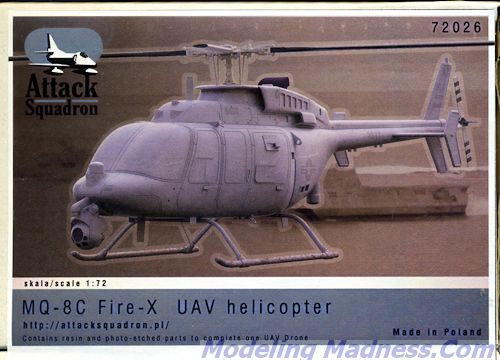
Attack Squadron 1/72 MQ-8C Fire-X
| KIT#: | 72026 |
| PRICE: | 30 Euros SRP from www.armahobby.com |
| DECALS: | Two options |
| REVIEWER: | Scott Van Aken |
| NOTES: | Resin kit with photo etch and 3D printed parts |

| HISTORY |
On 3 May 2010, Northrop announced plans to fly a Bell 407 helicopter modified with autonomous controls from the MQ-8B. Named Fire-X, it was to demonstrate an unmanned cargo resupply capability to the US Navy. The unmanned Fire-X completed its first flight at Yuma Proving Ground in Arizona on 20 December 2010. On 23 April 2012, Northrop received a $262.3 million contract from the Navy to build the newly designated MQ-8C Fire Scout; the work included two developmental aircraft and six low-rate production aircraft initially. The Navy wants 28 MQ-8Cs for naval special operations forces. The MQ-8C weighs 2.7 tons, has a 1,000 lb payload, and has an endurance of up to 24 hours. It can be armed with AGM-176 Griffin missiles and APKWS II guided 70 mm rockets that the MQ-8B can carry, as well as heavier AGM-114 Hellfire missiles. The MQ-8C is expected to enter service in 2014. Northrop Grumman flew the MQ-8C demonstrator installed with their AN/ZPY-1 STARLite Radar, although there was no requirement for an MQ-8C radar; the Navy began seeking information for a radar for the MQ-8C in July 2014 with surface search, synthetic aperture radar, inverse SAR, and weather mode capabilities. In March 2013, the Navy incorporated the Rolls-Royce 250-C47E into the MQ-8C for a 5 percent increase in "hot and high" power, 2 percent reduced fuel consumption, 8 percent increase in rated takeoff power, and better reliability.
In early July 2013, Northrop Grumman delivered the first MQ-8C to the Navy. Ground testing was done to ensure that the systems worked properly and communicated with the ground control station prior to conducting the first flight. The MQ-8C shares software, avionics, payloads, and ship ancillary equipment with the MQ-8B, while the upgraded airframe provides double the endurance and three times the payload. The MQ-8C was expected to fly in early October 2013, and be deployed in late 2014. The APKWS II will be added to the C-model sometime after 2016. Initial at-sea tests will be performed aboard the destroyer Jason Dunham in 2014. On 24 September 2013, the MQ-8C Fire-X delivered to the Navy turned on its engines for 10 minutes in preparation for first flight. A second MQ-8C was to be delivered on 30 September. First flight was scheduled for early to mid-October, although the exact date was not determined, as such tests are often delayed by minor system problems. The MQ-8C flight test regime is to last six months.
The MQ-8C Fire Scout first flew on 31 October 2013. It flew for 7 minutes in restricted airspace using autonomous controls at Naval Base Ventura County. It flew a second time hours later that day to an altitude of 500 ft. The MQ-8C was jointly operated by Northrop Grumman and the Navy. Northrop Grumman delivered the second MQ-8C on 25 November 2013. They are under contract to build 14 helicopters. The second MQ-8C flew on 12 February 2014. The aircraft had flown 66 hours by February 2014. On 10 March 2014, the MQ-8C reached 100 flight hours. 19 C-model Fire Scouts are on order with two in flight testing.
| THE KIT |
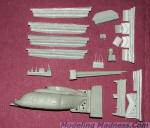 Attack Squadron has been producing resin kits for a short while and this is the second of their resin kits I have had the opportunity to review. Like the first one, I am quite impressed with the quality of the resin parts. In short, they are flawless with no molding glitches on any of the parts that I could see. There are several major parts with a multitude of smaller bits. The main pieces consist of the UAV's body, tail boom, fin, rotor blades, and the landing skids. There are more pieces for a myriad of smaller pieces. The braces for the landing skids are to be made from a length of thick copper wire, for which a form is provided.
Attack Squadron has been producing resin kits for a short while and this is the second of their resin kits I have had the opportunity to review. Like the first one, I am quite impressed with the quality of the resin parts. In short, they are flawless with no molding glitches on any of the parts that I could see. There are several major parts with a multitude of smaller bits. The main pieces consist of the UAV's body, tail boom, fin, rotor blades, and the landing skids. There are more pieces for a myriad of smaller pieces. The braces for the landing skids are to be made from a length of thick copper wire, for which a form is provided.
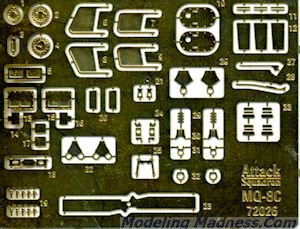 The kit has only one option and that is to use either a resin or a photo etch tail rotor. The 3D main rotorhead is one of the finest castings I have
The kit has only one option and that is to use either a resin or a photo etch tail rotor. The 3D main rotorhead is one of the finest castings I have 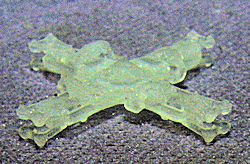 ever seen, if you can call it a casting. The instructions tell you to lightly sand it and wash it prior to use. The kit includes quite a few antennas, as well as a nicely done photo etch fret which contains all sorts of bits and pieces. On the nose is a FLIR pod, which I imagine also contains a video camera to assist the pilot with flying the vehicle. I don't anticipate this kit having any issues with tail sitting thanks to the soled main fuselage. One benefit of doing this sort of kit is that you don't have to worry about clear bits!
ever seen, if you can call it a casting. The instructions tell you to lightly sand it and wash it prior to use. The kit includes quite a few antennas, as well as a nicely done photo etch fret which contains all sorts of bits and pieces. On the nose is a FLIR pod, which I imagine also contains a video camera to assist the pilot with flying the vehicle. I don't anticipate this kit having any issues with tail sitting thanks to the soled main fuselage. One benefit of doing this sort of kit is that you don't have to worry about clear bits!
Instructions are well drawn and in English, providing detailed information on several aspects of the build. The drawings are quite well done and show precisely were all of the pieces are to be placed, so that even a beginner should have no issues during construction. The decal sheet contains markings for two aircraft One has a VX tail code and the other an NG code. A web search will find photos of the aircraft with both 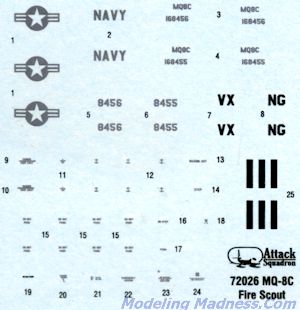 codes so you will not be doing a 'whiffer'.
codes so you will not be doing a 'whiffer'. 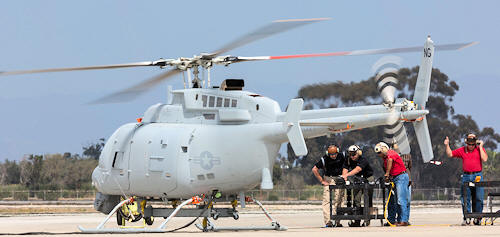 The aircraft is an overall FS 36375 which is, I believe, Light Ghost Grey, so painting won't be an issue. Note that the tops of the rotor blades are in broad red and white bands. The decal sheet is very nicely printed and it looks like it has a single clear coating over it, but I've been fooled before by sheets that look like that, but actually have all the markings separate.
The aircraft is an overall FS 36375 which is, I believe, Light Ghost Grey, so painting won't be an issue. Note that the tops of the rotor blades are in broad red and white bands. The decal sheet is very nicely printed and it looks like it has a single clear coating over it, but I've been fooled before by sheets that look like that, but actually have all the markings separate.
| CONCLUSIONS |
To those of us who have not kept up to speed on these sorts of things, it very well seems that in the last 10 years there has been an explosion in different types of UAVs. These are now becoming a major component of both the regular US military as well as the guard and probably reserves as well. This is one of the more interesting aircraft and one that will not take up a ton of space on your display shelf.
| REFERENCES |
http://en.wikipedia.org/wiki/Northrop_Grumman_MQ-8_Fire_Scout#MQ-8C_Fire-X
August 2014 My thanks to www.armahobby.com for the preview kit. Visit the link to get yours today.
If you would like your product reviewed fairly and fairly quickly, please contact the editor or see other details in the